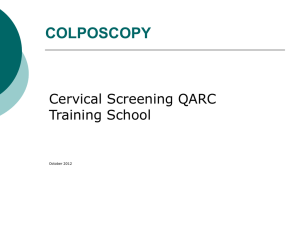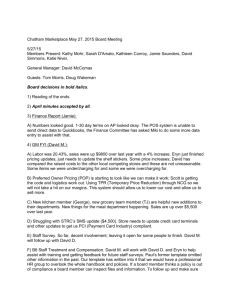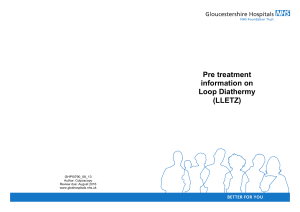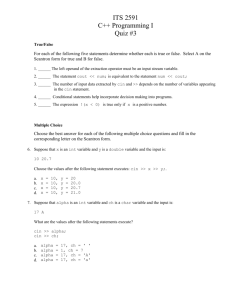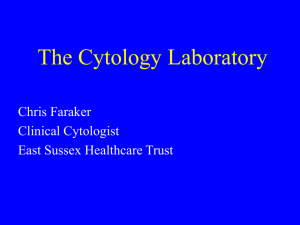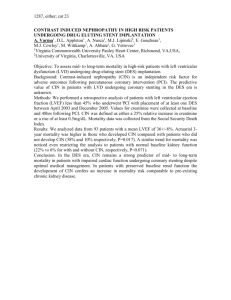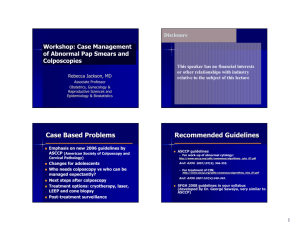servikal-sitoloji-histoloji-tjod2013
advertisement
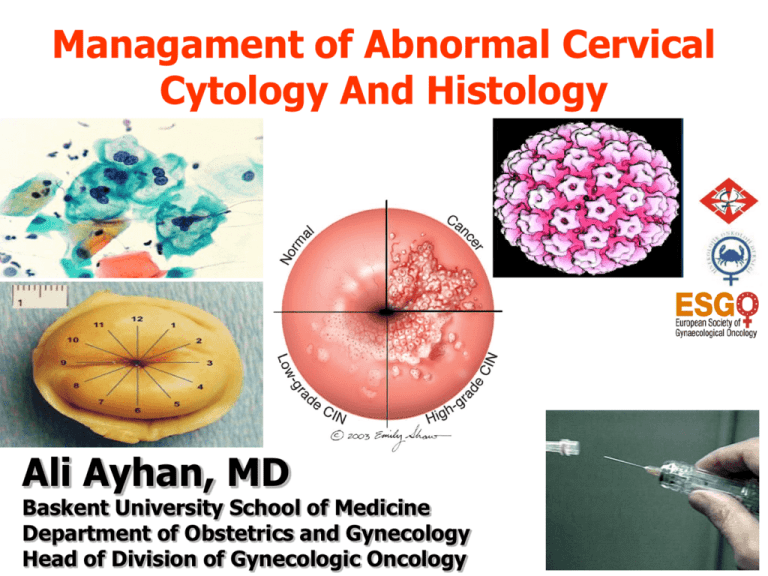
Managament of Abnormal Cervical Cytology And Histology Ali Ayhan, MD Baskent University School of Medicine Department of Obstetrics and Gynecology Head of Division of Gynecologic Oncology Globocan 2008 Cervical Cancer Case (n) Death (n) Worldwide 529.000 274.000 Developed countries 76.000 33.000 Developing countries 452.000 241.000 Turkey 1.443 Incidence 4,2 / 100.000 Mortality 1,6 / 100.000 556 HPV - Cervical Cancer Normal epithelium Screening HPV infection coilocytosis decads years months CIN1 ASC-US/LSIL CIN2 CIN3 HSIL Treatment SIL = Squamous Intraepithelial Lesion / CIN = Cervical Intraepithelial Neoplasia Carsinoma Abnormal Cytologic Findings: (The TBS, 2001) • AS cells: ASC – US ASC – H • LSIL • HSIL • AG cells AGC – NOS AGC – favor neoplasia • AIS • Invasive Cancer Abnormal Cervical Cytology in Turkey : A Turkish Gynecologic Oncology Group (TGOG) Study Ayhan et al, Int J Gyn Obst, 2009 Abnormal Cytology(2481/140334) • ASC – ASC-US rate – ASC-H rate – LSIL rate – HSIL rate %1.76 (n=2341) % 1.66 (n=1510) (n=100) (n=429) (n=243) %1.07 %0.07 %0.3 %0.17 • AGC (n=111) 0.07 • Cytologic Ca (SCC+Adeno, n=88) 0.062 Abnormal Cytology USA* (%) ASC-US LSIL HSIL AGC 4.3 1.6 0.2 0.3 TR (%) 1.07 0.33 0.17 0.07 * 2012 ASCCP Modern Colposcopy 2012 Abnormal Cytology-ASC Abnormality ASCS* Biopsy ASC-US 5-12% CIN 2-3 0.1-0.2 InvC 24-94% CIN 2-3 ASC-H LSIL HSIL *Immunosupresyon, HPV 15-30% CIN 2-3 26-68% CIN 2-3 1-2% InvC 10 Risk for detection of CIN 2 + at Colposcopy ASCUS HPV + %17-20 HPV - % 0,74-1,2 Total Risk %6,4-11,9 Abnormal Cytology-AGC Abnormality Biopsy AGC 9-54% CINs 0-8% AIS <1-9% InvC AGC-NOS 9-41% (CIN2-3, AIS, InvC) AGC-Favor neoplasia 27-96% (CIN2-3, AIS, InvC) AIS 48-69% AIS 38% InvC 12 Risks of CIN 2-3 and ICC Pap/HPV Risk of CIN2-3 Pap(-) HPV(+) ASC-US ASCUS HPV(+) ASCUS HPV(-) ASC-H LSIL HSIL 4 6-12 17-20 <2 27-51 15-30 >70 Risk of ICC 0.1-0.2 <0.1 1-2 Management of Abnormal Cervical Cytology • Patients age • Type of abnormality (Sq. vs. Glanduler) • Grade • Available tests (HPV,Colposcopy) • Special situations (Menopause,pregnancy,adeloscent, immunosupression) Management of Pregnant women LSIL Colposcopy (preferred approach for non-adolescent) No CIN2,3 OR CIN 2,3 Postpartum Follow-up Defer Colposcopy (until at least 6 weeks postpartum Manage per ASCCP guideline HSIL in Pregnancy • Colposcopy is recommended • Biopsy of suspicious lesions for CIN2/3 or cancer is preferred • ECC is unacceptable • Diagnostic exicion is unacceptable unless invasive cancer • Reevaluation with cytology and colposcopy is recommended no sooner than 6-wk postpartum(with HSIL in whom CIN 2/3 is not diagnosed) New Terminology •LGL (CIN1 ±HPV) •HGL (CIN2, CIN3) Incidence of Preinvasive Lesions 27 / 100000 (1980)* 54 / 100000 (1990)* 1.5 – 6% of all cytologic spesimens * SEER 5-year Survival in Cervical Cancer Pre-invasive Early localized Regional spread Distant met. (%) 100 92 49 14.9 Am J Obstet Gynecol, 13-20, 188, 2003 (SEER) Fundamental Objectives of Managing Preinvasive Lesions • Find the lesion • R / O invasion • Preserve fertility • Employ cost-eff. and low morbid techniques The Aim of Therapy in Preinvasive Lesion •Local control •Prevention of ICC •Decreased mortality CIN 1 • 60 % Regression • 30 % Persistence • 9 % CIS • 1 % Invasive Cancer CIN 2 • 40 % Regression • 40 % Persistence • 15 % Progression to CIS • 5 % Invasive Cancer CIN 3 •56 % Persistence •33 % Regression •12 % Invasive Cancer Which Lesions to Treat? • all lesions selected lesions • CIN 1...............1%(ICC) • CIN 2...............5%(ICC) • CIN 3.............12%(ICC) Therapeutic Tools • Ablation (destruction) • Excision • Photo – dynamic therapy • Non – surgical* • Expectant management * Vidarabine, Podophylline (CINs + HPV) Ablative or Local Destructive Methods: • Cryo – surgery • ECD • Cold coagulator • CO2 laser * No further histologic exam. Excisional Tools* • CONE • CKC • Laser • LEEP • Hysterectomy * in selected patients Indications for Excisional Therapy • (+) ECC • cyto – histology discrepancy • Microinvasion • AIS • unsatisfactory colposcopy Distribution of CIN Cases 57,7 60 50 40 30 24,2 Patoloji sonuçları 17,4 20 10 0 0,7 CIN 1 CIN 2 CIN 3 CIN 1-3 n=281 CIN 1-3 CIN1: 68 CIN2: 48 CIN3: 162 Ayhan A et al., 2007 Treatment Modalities used in Our Center 60 50,5 50 40 30,6 30 17,1 20 10 0,7 0 observation 1,1 Laser Con. TAH/BSO LEEP Ayhan A et al., 2007 Results of Re-conization after Positive Surgical Margins in CIN 2-3 n=56 50 45 40 35 30 25 20 15 10 5 0 49,1 37,7 11,3 1,9 Cr. servisit CIN 3 Invazive Ca CIN 2 Ayhan A et al., 2007 (under review) Cryotherapy Laser LEEP ColdKnife Conization success rates of various methods for the treatment of CIN are similar (up to 97%) • N=28 randomized study • The evidence suggests that there is no obviously superior surgical technique for treating CIN Reason of Treatment Failures • poor techniques • Glandular involvement • grade of CIN • size of lesion • margin status AIS AIS Incidence :1,25/100.000 CIN 2-3 :41.4/100.000 Charareteristics of AIS; -Multifocality -Colposcopic evaluation limited -Complete excision difficult -Skip lesions (Margin(-) Residu (+) ) Management of CIN-2/3 in pregnant women • Minimal invasive management • High regression • Repeat cytology/colposcopy (for every 12week) • Repeat biopsy (colposcopic – epithelial inv ca?) • Reevaluation postpartum after 6weeks • No treatment during pregnancy Posttreatment follow-up • Why? –İnvasive Cx Ca increase 10 fold –Non invasive 1-21% • Which tools? –HPV (6-12 ms) –Cytology only (6-12 ms) –Cytology + colposcopy (6-12 ms) Grade, size, margin status , histology…….. New Cervical Cancer Screening ACS 2012 • Cervical cancer screening should begin at age 21 years, regardless of the age of sexual initiation or other risk factors • For women 21to 29 years of age cytology alone and every 3 years • 21 to 29, 2 or more consecutive negatif cytology, screening interval longer than 3 years • İn this age group, HPV testing should not be used New Cervical Cancer Screening ACS 2012 • Age 30-65, – HPV + cytology every 5 years – Cytology alone, every 3 years – In this age group should not be screened with HPV testing alone – >65 years, negative prior screening and no history of CIN2+ within the prior 20 years should not be screened – Recommended screenin practice should not change on the basis of HPV vaccination status Cervical Cancer Screening in Turkey • Cervical cancer screening begin at age 30 years • Cervical cancer screening finish at age 65 years if negative 2 or more consecutive cytology • Repeating every 5 years • Screening in KETEM Conclusion • Cervical cancer increasing in Turkey. • Abnormal cytology is lower than western countries • Cytology reduce invasive cancer and mortality • Abnormal cytology is not enough for treatment • Abnormal cytology- colposcopy -directed biopsy –finally treatment Thank you for your attention...
